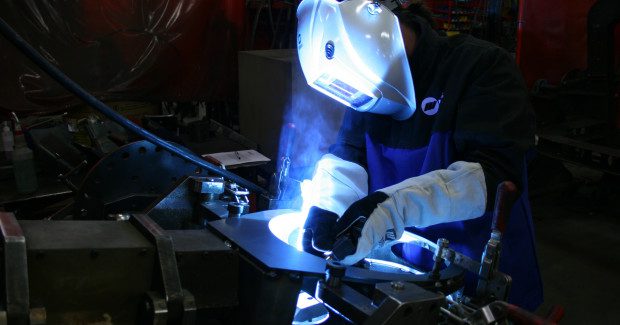Blueprint for the Future
Fabricators must continually explore new technologies that will grow along with their operations to help them stay competitive, profitable, productive, and ahead of the curve so they are prepared for the demands of the future.
Posted: November 7, 2015
New welding technologies make it easier for metal fabricators to be successful, despite evolving industry demands. This is the operational blueprint for shops seeking ways to stay competitive as they face numerous challenges, including a growing shortage of welding operators and the introduction of new materials. By following this blueprint, they will discover how welding equipment manufacturers are continually bringing new and varied solutions to market that can help both large and small job shops improve their productivity and quality, while also saving money.
SIMPLIFYING TRAINING
One of the biggest challenges facing shops today is the growing shortage of skilled welding operators, a gap that is expected to reach 400,000 operators by 2024. This lack of skilled welders can definitely hinder the ability of fabricators to meet continued customer demands. Welding OEMs answer this challenge by designing new technologies aimed at simplifying and reducing the time required to train new operators.
Specifically, power sources are now available that make it easier for welding operators of varying skillsets to create quality welds even with the presence of changes in stickout, torch angle and travel speeds common to those newer to the process. The improved arc performance of these power sources gives entry-level welding operators the ability to deliver a better weld faster, with less training. Easier-to-use equipment also provides shops with a means to attract more in-demand, skilled welding operators. The cumulative result is greater productivity for the companies without sacrificing quality.
https://youtu.be/edfBZx-SvCI
Many newer machines also offer the ability to perform advanced welding processes, like modified short-circuit MIG, which can provide performance efficiencies and ease-of-use benefits. This process, in particular, anticipates and controls each short circuit, then reduces the available welding current to create a consistent metal transfer. Along with its ability to maintain the same arc length regardless of stickout, this process makes it much easier for welding operators to control the weld puddle.
Simplified user interfaces help take the guesswork out of programming the machine, also making it easier to train welding operators. Some machines even show full words and descriptions on an easy-to-read digital display.
NEW MATERIALS
The introduction of different materials to the industry, and the increased use of those like aluminum, is another factor driving the demand for new welding technology. New materials are being used in some applications to reduce the weight of finished products and to lower product and production costs. For example:
- Traditional low carbon steels are being replaced in the heavy equipment industries by high-strength steels (HSLAs) or those ranging up to 85 ksi.
- Advanced high strength steels (AHHS) with mechanical properties as great as 140 ksi are being used for automotive components combined with galvanized coatings.
- Many general fabricators are using more aluminum and stainless steels, as well as other non-ferrous and more exotic materials in their product designs.
While many of these new materials improve the product quality, they can pose challenges for the welding process, such as burn-through, distortion or porosity. Higher-strength steels that are typically used at thinner dimensions can be more sensitive to cracking, which creates the need to preheat or establish new methods to control heat during the welding process. Another example is the galvanized coating used for corrosion-protection on thinner sections of steel, which can increase spatter and sub-surface porosity.
Dedicated welding systems designed for these specific materials and more advanced welding processes are two solutions that can help address such challenges. Pulsed MIG welding, for example, has proven effective in welding higher-strength steels, as well as galvanized steels. Synergic welding systems are another increasingly popular option to address the needs of welding materials such as aluminum. These systems use an operator-friendly, pulsed MIG welding technology that communicates completely between the power source, feeder and gun. With a standard Pulsed MIG system that is not synergic, a welding operator may change other settings if he or she changes the wire feed speed. With a synergic system, a change in wire feed speed by the welding operator means other settings are automatically adjusted by the machine so there is a constant welding arc and greater control for better weld quality.
FLEXIBILITY FOR NOW AND THE FUTURE
Job shops must continue to explore new technologies that can help them stay competitive, profitable, productive, and ahead of the curve. It’s also important that welding OEMs continue bringing new technologies to the market that will help these fabricators overcome ever-changing industry challenges. New technologies that will grow along with a shop’s operations can enable them to meet the needs of the present — and be prepared for the demands of the future.












